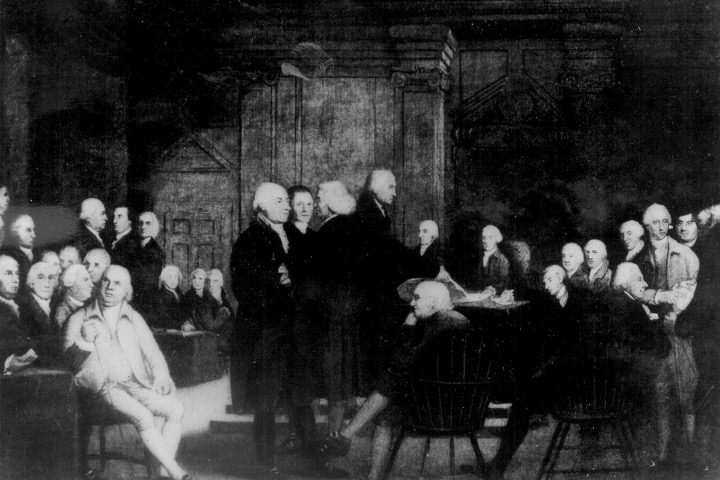
Standing at this end of history, we know that as the calendar changed from August to September the historic Constitutional Convention of 1787 was just a couple of weeks from being adjourned by convention president George Washington.
The representatives assembled, however, had no idea how much longer it would take to produce a document that could attain the approval of the states of the American confederation. In the days since the middle of May when business began in earnest (a couple of weeks later than scheduled due to the delayed arrival of delegates), the focus had expanded from proposing amendments to the Articles of Confederation to considering an entirely new constitution establishing an entirely new form of government. Not a man among them could have predicted the future of such revolutionary changes.
As we have covered in a series of articles this summer, the agenda for the convention was set by Virginia when state governor and convention delegate Edmund Randolph presented the Virginia Plan. The points of that plan framed the debates going forward, and the additions and subtractions to the provisions of the Virginia Plan created a first draft of a constitution, which itself was the subject of the deliberations from August 6, when it was presented by the committee.
Beginning on September 3, the delegates took up the provision of the first draft of the Constitution concerning the concept of term limits. Given the popularity of such a proposal today, looking back on the record of the convention’s debates on that subject is especially appropriate.
The theory of rotation in office was interpreted very differently in the state governments. Many of the delegates who served in state governments in pre-Revolutionary times were steadfastly devoted to the concept of regular rotation. In fact, the Articles of Confederation included a provision that no member of Congress should be “capable of being a delegate for more than three years in any term of six years.”
While the provision was popular in theory, in practice it worked very badly, serving to prevent the reelection of delegates just at a time when their experience would have made them most valuable to their states. No delegate was more familiar with the failure of the theory than James Madison, himself having been term-limited out of serving the state of Virginia in the Confederation Congress.
Ironically, Madison served on the committee of the Confederation Congress that recommended the rotation provision. Along with Alexander Hamilton and Thomas Fitzsimmons, Madison submitted the following report of the committee to the Confederation Congress in 1782:
The truth is, the security intended to the general liberty in the Confederation consists in the frequent election and in the rotation of the members of Congress, by which there is a constant and effectual check upon them. This is the security which the people in every state enjoy against the usurpations of their internal government, and it is the true source of security in a representative republic.
Back in Philadelphia, as the subject came up in the context of the new constitution that was soon to be recommended to the states, Gouverneur Morris argued that this doctrine of rotation formed “a political school in which we were always governed by scholars and not by their masters.” In other words, the frequent rotation of officeholders prevented people from ever acquiring the skills necessary to be effective legislators.
George Mason of Virginia, one of several senior statesmen seated there in Philadelphia, took to his feet to argue against Morris’ position. As Madison reports, Mason,
having for his primary object, for the pole-star of his political conduct, the preservation of the rights of the people, he held it as an essential point, as the very palladium of civil liberty, that the great officers of state and particularly the executive, should at fixed periods return to that mass from which they were at first taken, in order that they may feel and respect those rights and interests which are again to be personally valuable to them.
A few months later, at the Virginia Ratifying Convention, Mason would make the same observation during his speech recommending rejecting the Constitution. Edmund Randolph responded, asserting that term limits would cause a representative to “lean to the augmentation of his private emoluments.” Allowing the people to decide whether the candidate was worthy of reelection, however, would tend to make a man “more attentive of [the people’s] interests.”
James Wilson agreed with this position. During the debates that began on September 3, he argued that so long as the right of the people to elect their representatives was protected, then predetermined term limits would have the effect of “fettering elections and discouraging merit.”
Morris rose again, agreeing with Wilson’s view on the subject, saying, “The ineligibility proposed by the [term limits] clause as it stood tended to destroy the great motive to good behavior, the hope of being rewarded by a re-appointment. It was saying to him, ‘make hay while the sun shines.’”
As he so often and ably did, Roger Sherman showed there was a middle way, a way that frequent elections and limited terms could work to the advantage of everyone. Sherman said, “Frequent elections are necessary to preserve the good behavior of rulers. They also tend to give permanency to the Government, by preserving that good behavior, because it ensures their reelection.”
Ultimately, the arguments in favor of leaving the people free to reward good representatives with reelection and to deny office to those shown to lack integrity or to disregard the interests of the people won the day. This way, the chief cornerstone of republican government — the right of the people to elect their representatives — is protected, as is the ability of the people to exclude or expel the unworthy from occupying positions of power.



